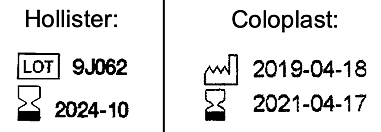
Many ostomy products include materials such as adhesives which degrade over time, and therefore have a limited shelf life. Product boxes usually include codes indicating both the manufacture date and expiration date. Here are examples from Hollister and Coloplast:

In the case of Hollister, the first two characters of the lot number (9J062 in this example) denote the year and month of manufacture. Here, “9” is the last digit of the year, presumably 2019 (It might also be 2009 or 1999 but, seeing this in 2020, we assume we aren’t dealing with product that old). “J” denotes the month of manufacture (where “A” is January, “B” is February, etc.), so this product was manufactured in October 2019. The expiration date in Year-Month format is shown next to an hourglass symbol; in this case, the product expires in October 2024. That’s 5 years after the manufacture date, so this product is marked as having a 5-year shelf life.
Coloplast labels display both the manufacture date and expiration date explicitly in international Year-Month-Day format, showing the manufacture date next to a symbol that represents a factory, and the expiration date next to an hourglass icon. In this case, the product was manufactured on April 18, 2019 and expires on April 17, 2021. Thus, this product is marked as having a 2-year shelf life.
ConvaTec labels may be marked using a variety of encoding schemes. Sometimes, mainly on newer products, the manufacture date and expiration date are both displayed. However, some ConvaTec labels display only a lot number (where the first two characters encode the year and month of manufacture in the same way as Hollister lot numbers). These labels may not display an expiration date at all. In these cases, the working assumption is to assume a 5-year shelf life, so the expiration date is 5 years after the manufacture date.
As an interesting observation, some products with newer skin barrier formulations have shorter shelf lives than earlier products. For example, Coloplast’s “Sensura Mio” skin barrier, used in all their newer pouching systems, has only a 2-year shelf life (the Coloplast label pictured above is from a box of Sensura Mio pouches). Hollister has traditionally had a 5-year shelf life for most products, as in the example pictured above, but I noticed that a box of Hollister pouches containing their newer “CeraPlus” skin barrier was marked as having only a 3-year shelf life.*
As consumers, we should be aware of the expiration dates of products we purchase. Legally, a supplier can’t sell products after their expiration dates, but performance of products may deteriorate as they get close to expiration. As a general rule, always use products with the earliest expiration dates first. It sometimes happens that a newly purchased box of products has an earlier expiration date than a previously purchased box that you’re still using. When that happens, use up the newly acquired box before returning to the previously purchased box with the later expiration date.
*Note added January 2023: Some boxes of Hollister CeraPlus products were marked as having 3-year shelf life when this article was written in 2020. Now, similar Hollister CeraPlus products are marked as having 5-year shelf life.
OstomyOK Home
| What is Ostomy?
| Ostomy Care Guides
| Ostomy Supplies
| Newsletter
UOAA Discussion Board
| UOAA Support Groups
| Contact Webmaster
| Search
| Links